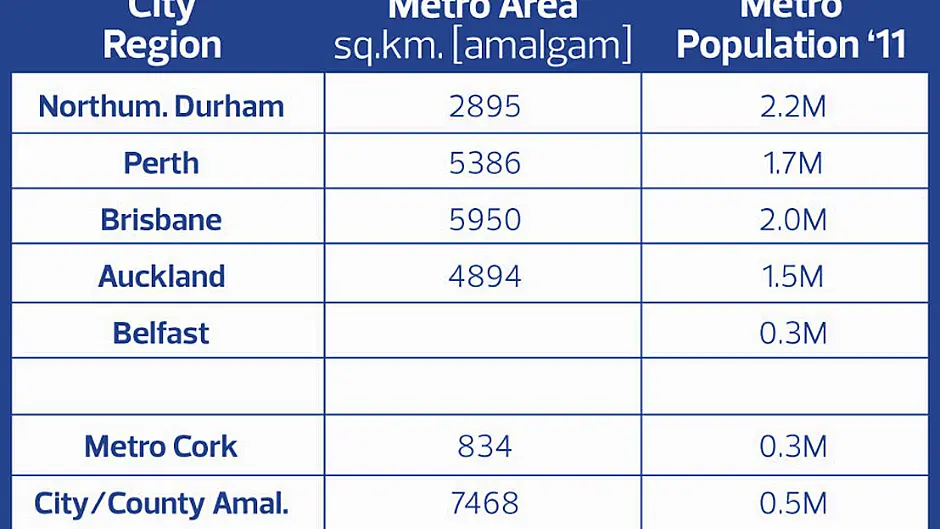The recommendation of the Smiddy committee, set up to advise on local government in Cork, to amalgamate city and county in a single authority has given rise to some controversy inside and outside the committee.
THE recommendation of the Smiddy committee, set up to advise on local government in Cork, to amalgamate city and county in a single authority has given rise to some controversy inside and outside the committee.
Not surprisingly, government action on the proposed merger is now deferred, at least until after the general election.
Does such reorganisation, as proposed by Smiddy, matter? Undoubtedly so for insiders, politicians and key officials, but for the public at large, probably not.
A reduction in the number of authorities and in expenditure/staff is envisaged. Vague promises by government to extend the functions of local government to include aspects of health, security and education are made in the policy document Putting People First but amalgamations of authorities and suppressions of town councils have been the main changes. The creation of municipal councils as divisions of county councils is a small step forward from county council area committees.
The proposed amalgamation in Cork follows the pattern of amalgamation in Waterford and Limerick, neither of which addressed a real issue for those cities, ie the creation of a single authority for the urban area in each city. Both these cities extend into a different neighbouring county. Cork occupies a central position in its county, but much of the so-called Cork metropolitan area is in the county. The fact that the extensive port lies in two jurisdictions is a particular difficulty for advocates of a single authority for the ‘metro’ area.
Much is made in arguing for amalgamation of city and county of the advantage of ‘a single voice for Cork’. What does this mean? Is the city in competition with Castletownbere or Youghal and are these towns in competition with each other? Is a super manager/executive going to resolve competition between localities or will they look to their real superiors in Dublin to resolve conflicts that arise?
The Smiddy report has concerns about the complexity of financial arrangements consequent on any expansion of the city boundary and those concerns have more or less stymied any option other than amalgamation. Surely, where there is a will, there is a way? Could not Cork (that is city and county) be split into separate authorities (as Dublin was)? Local democracy might be better served by the creation of separate authorities for those areas suggested as metropolitan and municipal districts in the report.
The latter have populations equivalent to mid-ranking county councils.
The achievements of towns like Midleton, Skibbereen and Clonakilty (incidentally towns which had urban councils) is widely acknowledged. It is unlikely that these communities attribute their success to wealth generated in ‘metro’ Cork. Respective independent councils in West Cork and East/North Cork are more likely to promote the development of Castletownbere or Youghal than a unified authority and are more likely to be effective units if the role of local government is expanded.
Another argument influencing Smiddy is that an expanded city will have less interest in protecting a greenbelt around the city and in urban renewal. Is it credible that a ‘metro’ council would be less interested in such issues than a unified authority for an area extending from Allihies to Araglin?
The committee is most seriously at fault in the interpretation of the research on international experience of local government reform, compiled for them by the Institute of Public Administration.
Cases are instanced which have little relevance to Cork. Birmingham and Manchester, for example, are cities at the core of dense urban agglomerations. Denmark, which has much to offer in examples of model local government, is mentioned without explanation.
The benefits of amalgamations in cities in Australia, New Zealand and the UK are cited. The amalgamations quoted are, in fact, closer to the metro region identified for Cork than the so-called urban region created by the amalgamation of city and county. The new Belfast urban region is smaller than ‘metro’ Cork but the impression created by the Smiddy report is that it has the character of the amalgamation proposed for Cork.
The county is too large and diverse to focus fully on the development of the city and harbour. However, it is probably futile to hope for a metro authority for Cork and appropriate reorganisations of the county area outside the metro area. Such reorganisation does not meet the template for reform designed by a bureaucracy with little regard for local need. Local government in this design merely co-ordinates implementation of national policy, essentially a ‘top-down’ approach. The current debate is not a city/county conflict, but an argument between those who want to see real local government and those who prefer rule from the capital. It is unlikely that the former will prevail.
This is an edited version of an article published recently in Pleanail, the journal of the Irish Planning Institute.








